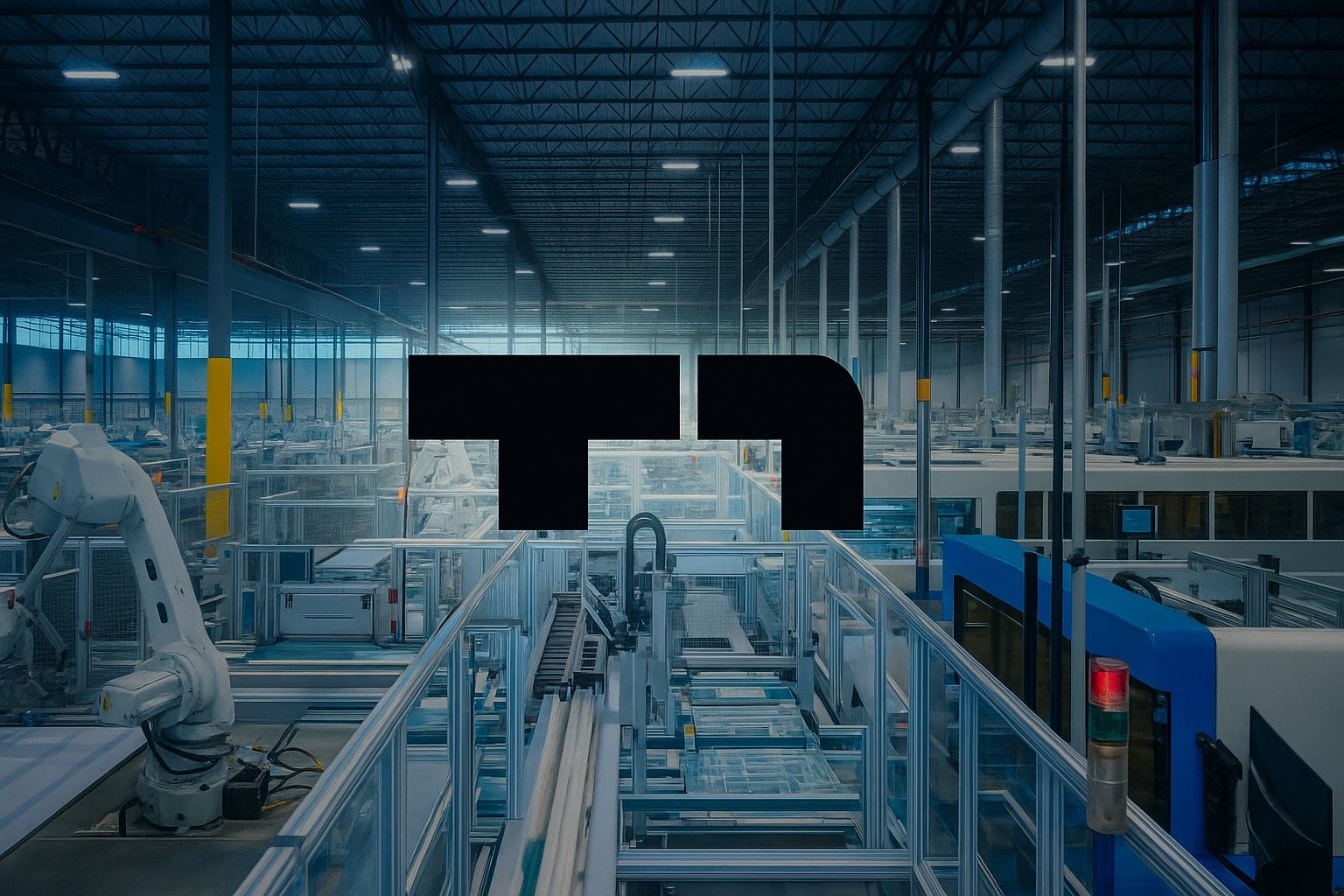- Stock jump: On Oct 15, 2025, T1 Energy (NYSE: TE) stock surged ~26% on news of a $75M+ supply deal with Nextracker for its new solar panel facility [1]. In premarket trading, TE had spiked over 34% to ~$5.37 [2].
- Strategic investments: On Oct 10, T1 announced a minority equity stake in Talon PV LLC (a Texas solar cell developer) via a SAFE agreement [3] [4]. This complements T1’s own 5 GW “G2 Austin” solar cell project (online 2026) and Talon’s 4.8 GW Baytown plant. CEO Daniel Barcelo said boosting U.S. solar cell output “is necessary to support energy security” [5].
- Domestic supply chain deal: On Aug 15, T1 struck a landmark partnership with Corning Inc., agreeing to buy American-made polysilicon and wafers for its Texas factories [6]. Barcelo called it “American companies building in America” and said it protects “American energy security” [7].
- Earnings results: In Q2 2025 (reported Aug 20), T1’s GAAP revenue was $132.8M (vs. $139.9M expected) and EPS lost $0.21 [8]. Cash reserves plunged to $46.7M (from $221.5M a year earlier) [9]. Management cited contract wins and policy tailwinds, but noted margin pressure and higher SG&A costs [10] [11].
- Background: Formerly Freyr Battery (Norway), the company rebranded as T1 Energy in Feb 2025 when it pivoted to U.S. solar PV manufacturing [12]. It acquired a 5 GW Trina Solar module plant in Wilmer, Texas (G1 Dallas), and is building a 5 GW solar cell factory (G2 Austin) [13] [14]. T1 focuses on vertically integrated solar and energy storage, leveraging U.S. tax credits and advanced manufacturing [15] [16].
Stock Performance and Recent Moves
T1 Energy’s shares have been on a tear in 2025. Before today’s jump, TE closed at $4.01 on Oct 14 (a 14.6% gain on the day) [17]. During premarket trading on Oct 15, the stock briefly touched $5.37 (up 34%) following the Nextracker news [18], before settling to around $4.91 (+22.6%) by 9:45 AM [19]. Over the year-to-date through Oct 14, TE was already up ~55% [20]. The one-year total return now exceeds 250% [21]. However, longer-term returns remain negative – about –70% over three years, reflecting early losses under the Freyr Battery era [22].
Investors have piled in on the back of T1’s string of new deals and production milestones. In just the past week, after the Nextracker frame agreement (valued at $75M over several years), TE shares shot up roughly 26% [23]. (Nextracker will supply its patented steel solar panel frames for T1’s Wilmer, Texas plant.) A day earlier, shares jumped on the Talon PV investment news [24] [25]. These moves extend a rally that saw TE climb nearly 95% over the prior month (as of Oct 12) [26], driven by optimism about U.S. solar manufacturing. By comparison, the 52-week range of TE had been roughly $0.92 – $5.10, reflecting the volatility around these developments [27].
Major Deals and Strategic Partnerships
T1’s recent partnerships underscore its strategy of reshoring the solar supply chain. The Nextracker deal (announced Oct 15) commits Nextracker to supply domestically made steel frames for T1’s G1 Dallas 5 GW module line [28]. CEO Daniel Barcelo remarked that with surging demand from AI and data centers, “the U.S. needs to establish critical energy supply chains built on domestic capacity,” and this agreement exemplifies that effort [29]. The companies will boost U.S. steel frame production (adding new Texas manufacturing lines) to replace imported aluminum frames [30].
On Oct 10, T1 invested in Talon PV LLC – taking a minority equity stake via a SAFE and exploring a broader strategic partnership [31]. Both firms plan to produce advanced TOPCon solar cells in Texas. T1’s own G2 Austin cell plant (5 GW, Rockdale TX) is due online in late 2026 [32], while Talon’s 4.8 GW Baytown cell plant aims for 2027. Barcelo said this investment “expands the output of American solar cells,” supporting U.S. energy security and regulatory compliance [33].
Earlier this summer, T1 secured a domestic supply chain deal with Corning (Aug 15). Under this partnership, Corning will supply ultra-high-purity polysilicon and crystalline wafers from its Michigan plant starting in H2 2026, to feed T1’s Austin cell factory and Dallas module line [34] [35]. Reuters reported the deal “connects polysilicon, wafers, cells and panels manufactured in the United States” [36]. Barcelo highlighted that this “landmark supply chain agreement” will help “invigorate America with scalable, reliable, low-cost energy,” with ~6,000 U.S. jobs involved [37]. This deal also positions T1 to qualify for new U.S. tax credits (Section 45X) that restrict foreign-made components [38] [39].
Other news includes long-term offtake contracts: in Q2 T1 said it had sold essentially all 2025 output from its G1 Dallas plant. Reuters notes a 437 MW utility-scale module sale (announced in summer) that effectively books out Dallas to ~2.6 GW [40]. (T1 now reports over 1.2 GW of cumulative Dallas production in 2025 [41].) These deals – selling to utilities and logistics firms – helped justify the expansion. T1 is also advancing its own G2 Austin project: construction is set to start later in 2025, with phase 1 online by Q4 2026 and ~$850M in investment required [42] [43].
Business Background
T1 Energy positions itself as a U.S.-focused solar and storage manufacturer. Originally Freyr Battery (headquartered in Norway), the company scrapped its large Georgia battery gigafactory in 2024 and rebranded as T1 Energy in early 2025 [44]. The pivot came with the acquisition of Trina Solar’s 5 GW solar module plant in Wilmer, Texas (now G1 Dallas) [45] [46]. T1 now has about 328 employees and operates that Wilmer module factory, producing PV panels (currently TOPCon cells) for sale under long-term contracts [47] [48].
The company’s strategy is to build an integrated U.S. solar supply chain: from polysilicon and wafers (with Corning) to cells (G2 Austin) to modules (G1 Dallas), plus energy storage solutions. It leverages U.S. policy incentives – notably the Inflation Reduction Act and Section 45X tax credits – that reward domestic production [49] [50]. As one analysis notes, rising U.S. electricity demand (AI data centers, EVs) and protective trade measures “position T1 as a key provider of solar modules and storage” [51].
T1 also maintains some legacy battery operations: a battery plant in Mo i Rana, Norway (“Giga Arctic”) is being repurposed for data-center and AI infrastructure uses as the firm shifts emphasis to solar [52] [53]. But the growth engine is clearly the Texas solar projects. Management repeatedly emphasizes “American energy, jobs and advanced manufacturing” as its mission [54].
Financial Results and Outlook
In its Q2 2025 report (released Aug 20), T1 Energy delivered mixed results. GAAP revenue was $132.8M, roughly 5% below the $139.9M analysts expected [55]. The GAAP EPS loss of $0.21 also exceeded estimates of $0.13 loss [56]. T1 cited strong module deliveries under contract, but high operating costs and SG&A expenses (which jumped over four-fold year-on-year) squeezed margins [57]. Gross profit was ~$32.8M in Q2 [58].
Meanwhile, T1’s cash position deteriorated: cash and equivalents fell to $46.7M by June 30, 2025 (down from $221.5M a year earlier) [59]. This drop reflects heavy R&D and capex for G2 Austin, as well as legacy operating losses. Debt stands above $640M with ~$8M interest per quarter [60]. Despite this, management reiterated full-year 2025 EBITDA guidance of $25–50M (after lowering it earlier due to policy headwinds [61]). They noted risks are skewed to the low end, given tariff uncertainty and a shift toward merchant sales in the industry [62].
In May 2025, T1 had actually trimmed its 2025 targets (Guidance cut: EBITDA now $25–50M vs. $75–125M prior [63]; production guidance lowered to ~2.6–3.0 GW vs. 3.4 GW [64]) amid trade-policy noise. CEO Barcelo then said the company was “well positioned” with about 1.7 GW of 2025 module contracts already secured [65]. Those contracts include supply agreements signed with utilities and the German firm RWE from the TrinaSolar acquisition.
Going forward, T1 expects G2 Austin to add major capacity. The first 5 GW phase (TOPCon cells) is slated to begin in late 2026 [66] [67]. To finance this, T1 is seeking roughly $850M in investments [68]. Full commercialization of G2 could fund the lofty “run-rate EBITDA” goal of $650–700M cited by management, but that remains a long-term ambition [69].
Analyst Views and Investor Sentiment
Analysts’ sentiment on TE is cautiously optimistic but mixed. Consensus ratings range from Hold to Buy: market data show 2 “Buy”, 3 “Hold” and 1 “Sell” among covering analysts this month [70]. The average 12-month price target is about $3.00 [71] [72], roughly 25–30% below TE’s recent prices. (For example, BTIG had raised its target to $4.00 in late 2024 [73].) The rally has far outpaced these forecasts; as one commentator notes, T1’s shares had climbed nearly 250% in a year and ~95% in the last month [74], raising questions of overvaluation. Simply Wall Street labeled the stock 21% “overvalued” as of Oct 12 [75] given lofty growth assumptions.
On the flip side, supporters point to policy and market tailwinds. T1’s niche in onshoring is underscored by the new U.S. push (e.g. the “One Big Beautiful Bill” Act) to restrict Chinese solar equipment. The Motley Fool (JesterAI) observed that T1’s Corning deal and module contracts could shore up its eligibility for new tax credits (45X) [76]. CEO Barcelo’s remarks have found resonance: he frames T1’s mission as rebuilding U.S. manufacturing (“American companies building in America” [77]) for strategic industries. One energy analyst commented that demand for solar in the AI/data-center sector and heavy investment in domestic facilities give T1 a compelling narrative [78] [79].
In sum, investor sentiment is bullish on T1’s story – U.S. solar independence – but cautious on near-term profitability. The stock’s recent leaps suggest market expectations are running ahead of fundamentals. As Investing.com notes, the Nextracker deal “has exceeded market expectations for T1 Energy’s strategic positioning” [80]. Many investors will be watching the upcoming Q3 results (due Nov 4) and any updates on G2 Austin financing. For now, T1’s heavy news flow and CEO’s high-visibility commentary (cited above) continue to drive excitement in the market.
Sources: News and filings from T1 Energy (NYSE:TE), including press releases and earnings reports, and analysis from Reuters [81] [82], Investing.com [83] [84], Mercom Capital Group [85], pv magazine [86] [87], Simply Wall St [88] [89], and MarketScreener [90] [91]. All key data cited above are from these sources. (Investors should consult original filings and financial reports for details.)
References
1. za.investing.com, 2. www.investing.com, 3. mercomcapital.com, 4. www.benzinga.com, 5. www.benzinga.com, 6. www.reuters.com, 7. www.reuters.com, 8. www.nasdaq.com, 9. www.nasdaq.com, 10. www.nasdaq.com, 11. www.nasdaq.com, 12. www.ess-news.com, 13. www.ess-news.com, 14. pv-magazine-usa.com, 15. www.marketscreener.com, 16. simplywall.st, 17. www.marketscreener.com, 18. www.investing.com, 19. www.marketscreener.com, 20. www.investing.com, 21. www.investing.com, 22. www.investing.com, 23. za.investing.com, 24. mercomcapital.com, 25. www.benzinga.com, 26. simplywall.st, 27. www.investing.com, 28. za.investing.com, 29. za.investing.com, 30. za.investing.com, 31. mercomcapital.com, 32. www.benzinga.com, 33. www.benzinga.com, 34. www.reuters.com, 35. pv-magazine-usa.com, 36. www.reuters.com, 37. www.reuters.com, 38. www.reuters.com, 39. www.nasdaq.com, 40. www.nasdaq.com, 41. www.nasdaq.com, 42. pv-magazine-usa.com, 43. www.nasdaq.com, 44. www.ess-news.com, 45. www.ess-news.com, 46. pv-magazine-usa.com, 47. www.marketscreener.com, 48. pv-magazine-usa.com, 49. simplywall.st, 50. www.nasdaq.com, 51. simplywall.st, 52. www.nasdaq.com, 53. www.ess-news.com, 54. www.ess-news.com, 55. www.nasdaq.com, 56. www.nasdaq.com, 57. www.nasdaq.com, 58. www.nasdaq.com, 59. www.nasdaq.com, 60. www.nasdaq.com, 61. www.pv-tech.org, 62. www.nasdaq.com, 63. www.pv-tech.org, 64. www.pv-tech.org, 65. www.pv-tech.org, 66. pv-magazine-usa.com, 67. www.nasdaq.com, 68. pv-magazine-usa.com, 69. www.nasdaq.com, 70. www.tipranks.com, 71. www.investing.com, 72. www.marketscreener.com, 73. www.investing.com, 74. simplywall.st, 75. simplywall.st, 76. www.nasdaq.com, 77. www.reuters.com, 78. za.investing.com, 79. simplywall.st, 80. www.investing.com, 81. www.reuters.com, 82. www.nasdaq.com, 83. za.investing.com, 84. www.investing.com, 85. mercomcapital.com, 86. www.ess-news.com, 87. pv-magazine-usa.com, 88. simplywall.st, 89. simplywall.st, 90. www.marketscreener.com, 91. www.marketscreener.com










